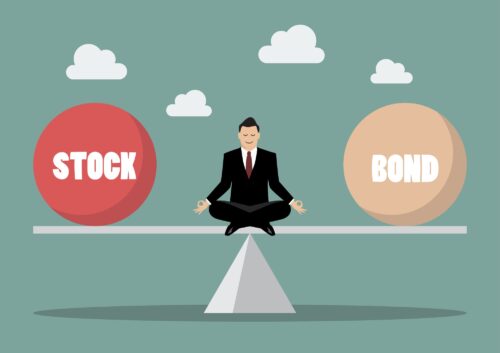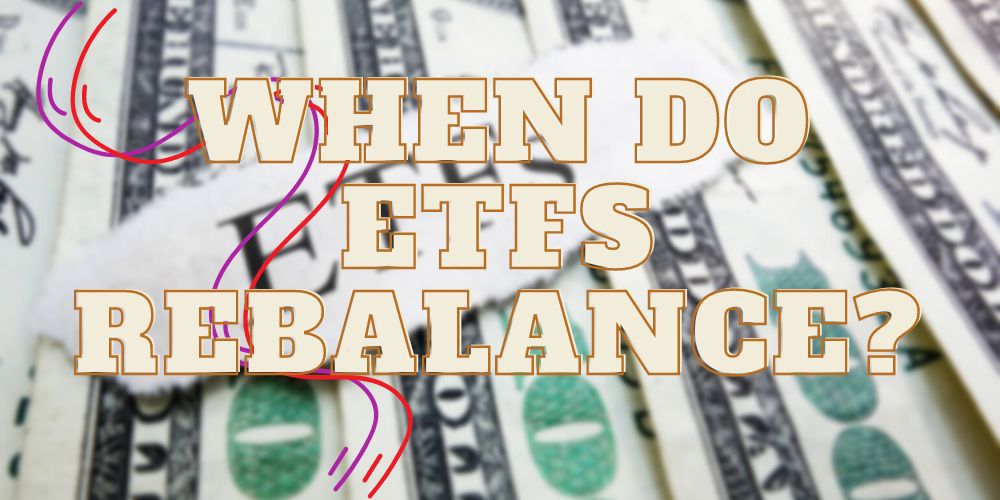Exchange-traded funds need to rebalance their portfolios regularly. This is because price movements in their underlying assets can cause a shift from their original mix. But when do ETFs rebalance? We look closely at the rebalancing process and the frequency with which different types of ETFs do it below.

About ETFs
An exchange-traded fund is a type of investment security that pools money to buy a basket of financial assets.
They may track equity indexes, commodities, a group of shares, or any other asset class traded on the markets. These funds are bought and sold just like securities. Hence, their prices can change at any time during the day.
Usually, most ETFs are passively managed and track specific indexes. Due to this reason, their expense ratios are significantly lower than similar instruments like mutual funds or REITs.
What Is Rebalancing?
Rebalancing is the process of adjusting portfolio holdings to realign with the risk and reward profile outlined in the investment plan.
Investors buy assets such as mutual funds or ETFs based on their tolerance for risk.
But over time, the allocation mix of various underlying assets might change due to price variations. To bring the portfolio back to the desired levels, fund managers rebalance the constituents by buying or selling some of them.

For example, let’s consider a mutual fund with a 50:50 equity vs. debt allocation.
In time, the weightage of equities might increase because the prices of the stocks tracked can go up. This can cause the fund’s profile to become slightly riskier.
There could be two ways to bring it back to the level originally intended. The fund might sell some of the equities or else increase the bond holdings to do it.
When Do ETFs Rebalance?
Rebalancing happens periodically depending on how quickly the prices of the underlying assets move.
The higher their volatility, the more frequent the need to rebalance.
For example, inverse and leveraged ETFs need to do it daily because they must replicate their promised leverages. Funds that largely deal in micro, small, and mid-cap securities would need to rebalance every few days.
Those composed mostly of bonds and fixed-income assets may do it only once a month.
ETFs that track hedge funds or other privately held entities depend on their quarterly SEC filings. Hence they might only rebalance once a quarter. Some ETFs follow rules-based tracking.
Their rebalancing mechanism is automatically triggered by the occurrence of certain defined events.
Lastly, passively managed ETFs usually do it on the day when the index rebalances itself after the close of trade. In the next section, we discuss why this method is inefficient.
Why ETF Rebalance Date Matters
In a 2021 paper by Ph.D. candidate Sida Li, it was highlighted that the mechanism by which passive ETFs rebalance themselves could cost them billions of dollars.
Many such funds track a benchmark index like S&P 500, which usually announces its rebalance date five days in advance. These index announcements are accompanied by upward movements in constituent stock prices.
Li assessed that the underlying shares moved by 67 basis points in the five days following the event.

They then moved downwards by 20 bps in the coming 20 days.
The tracking ETFs do their own rebalance after the closing of trade on the day when the index does it. This method is known as sunshine trading.
As per the research, such funds are inefficient because they miss out on available informational advantages.
In contrast, there are “Opaque ETFs” that do not time their own rebalancing in accordance with the underlying index. There are two strategies: those that hide when they trade and others that hide which securities are being traded.
In the first instance, the fund does not disclose when its rebalance happens.
They could either do it before the underlying index rebalances itself or after the impact of the exercise is over. Such funds have an advantage of up to 7.3 bps over their sunshine trading counterparts.
The second variety of Opaque ETFs has those funds that track indexes created by their own issuers. One typical case is the Schwab 1000 ETF tracking the Schwab 100 index.
In such cases, the fund rebalances itself actively as and when index constituent changes occur. There is no set date for it. Research has shown that such funds might gain an advantage of up to 30 basis points!
How Long Should You Leave Money in an ETF?
Holding an ETF for more than a year might be more profitable from a taxation perspective. This is because depending on how long you leave your money, it is taxed differently.
Any profits are treated as long-term capital gains if the units are held for more than a year.

Otherwise, they will be taxed at short-term capital gains rates.
Currently, long-term capital gains tax rates are
- 0 for the 10% tax bracket
- 10% for those in the 15% segment
- 20% for those taxed at 39.6%.
On the other hand, short-term profits are taxed at the ordinary income tax rate.
Note that the holding period is counted from the day after the order to purchase was placed.
What Happens to an ETF if the Market Crashes?
When market corrections happen, ETFs also fall with them. However, they almost always come back to go even higher when there is a rebound.
Moreover, since ETFs are diversified, it is possible that at least a few of their underlying stocks might survive the fall. Hence, sometimes, exchange-traded funds might perform better in a downturn.
In fact, a crash might be a good time to buy ETFs because they are priced low then.
What Is the Best Day to Buy ETFs?
Conventional wisdom says Mondays are the best to buy ETFs (or any other stocks, for that matter). Fridays are considered the worst.
Note that this advice is anecdotal; there is no real research behind it. During the day, it might be best to make transactions near the end of the trade.
This is because trading activity is high, so the bid-ask spreads are lower.
Are They a Good Investment?
Like most market instruments, ETFs have their pros and cons. Let’s discuss some of them below.
Benefits of ETFs
Diversification
ETFs help investors buy a basket of securities without having to collect them individually. For passive investors who just want to track a certain index, these funds are the best and most cost-effective way to do so.
Trading on Stock Markets
ETF trades happen just like shares. This is as opposed to other instruments like mutual funds, which are traded only once daily.
Due to this reason, they offer greater flexibility than comparable index-tracking mutual funds. For example, ETFs can be short-sold or have futures and options designed around them.
Lower Fees
Most ETFs follow passive investing. They merely track certain indexes. Hence, there are lower management fees and other marketing-related costs involved.
This brings down their expense ratios considerably compared to mutual funds with higher execution costs.
Tax Efficiency
The ETF unit creation and redemption process reduces the number of “taxable events” during rebalancing. Secondly, since the funds are passively managed, the need to sell and purchase underlying securities is lesser.

Both these factors come together to lower the investor’s tax burden.
Moreover, dividends earned from ETFs are taxed as capital gains, not as ordinary income.
Dividend Reinvestment
For open-ended ETFs, dividends are immediately reinvested, giving the maximum benefit to the holder. This differs from how mutual funds operate – their timing for reinvestment could vary.
Disadvantages
Coverage
In many sectors, ETF coverage is limited to only large-cap stocks. Since they are passively managed, most of these funds prefer not to get into the mid and small-cap segments.
This reduces the potential to offer higher growth for investors.
More Expensive Than Stocks
Even though it is small, there is a cost of acquiring and holding ETFs. On the other hand, most brokerage firms offer zero transaction costs for trading on stocks.
Do Not Work For Systematic Investment
While, in most cases, ETFs can be more cost-effective than mutual funds, they don’t work as well for small, regular monthly investing plans. These programs work on dollar-cost averaging, reducing risk while encouraging regular investing habits.
However, there is usually a fixed fee associated with such programs for every transaction, even for small investments.
In this case, mutual funds might perform better because they offer breakpoint sales, which ETFs do not.
Leveraged ETFs
Though they have the same name, leveraged ETFs are very different from normal ones. They are riskier and not meant for long-term trading.
Moreover, they need to rebalance every day and hence are more expensive.
Volatility
It has been speculated that exchange-traded funds cause their underlying stock to be more volatile.

This is because it is possible for their net asset values and market prices to be slightly different at times, creating an arbitrage opportunity.
Final Thoughts
ETFs rebalance as per the frequency at which their underlying assets change in price. There is a broad spectrum from leveraged funds, which rebalance daily, to hedge fund-based ones, which do it only once a quarter.
The most intriguing case is that of passively managed index-tracking funds. How and when they rebalance themselves can create an inefficiency in their returns, which might cost investors.
Opaque ETFs perform better by hiding their rebalancing strategy, while those that do not might suffer.


 Tags:
Tags:










